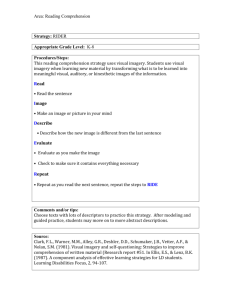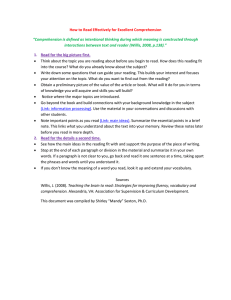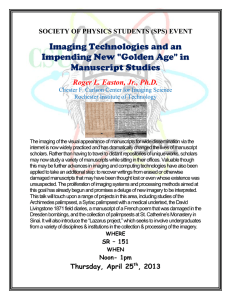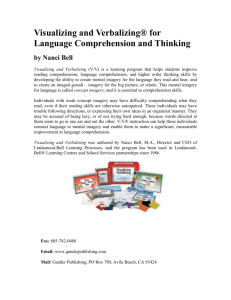Pairing Functional and Academic Skills: Teaching Language Comprehension and Pedestrian Travel Training
advertisement
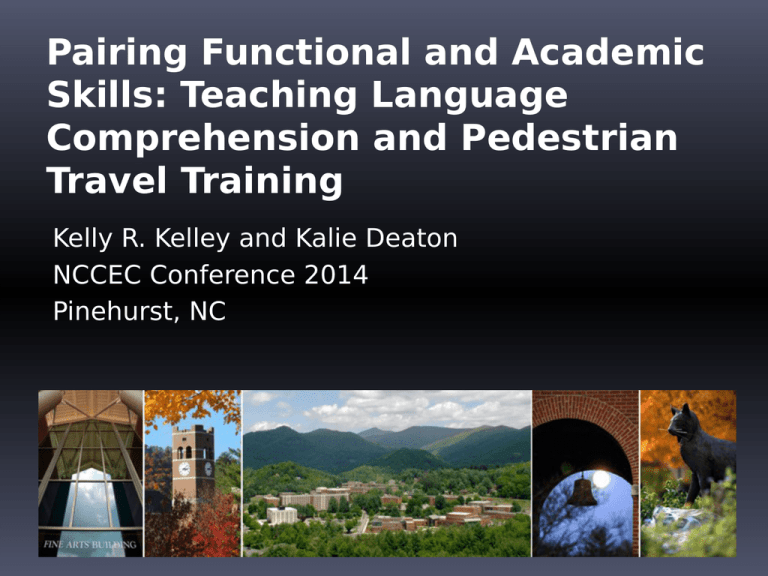
Pairing Functional and Academic Skills: Teaching Language Comprehension and Pedestrian Travel Training Kelly R. Kelley and Kalie Deaton NCCEC Conference 2014 Pinehurst, NC UP Program Overview • The University Participant (UP) Program is a two year, inclusive program for college-aged individuals with intellectual disabilities. • Operated as a pilot program from 2007 to 2010; 2 participants completed the program by 2010. • Expanded to 4 participants in 2010, 4 additional in 2011 for a total of 8 participants. • Funded as a model demonstration site in UP Participant Activities • Live in campus residence halls and experience college life with same age peers • Have an individual plan that would allow personal development for post-UP success • Attend and audit a limited number of classes • Participate in social events and activities UP Program Components Personal Develop ment Course Auditing Social Participa tion and Learning Communit y Participati on Vocatio nal Prepara tion Participants must pay current university fees for auditing courses UP Certificate Requirements UP Certificat e of Accomplis hment 1800 hrs in 4 semeste rs 80% of objectives in IPCP* Recommendat ion based on satisfactory progress *Individual Plan for College Participation (IPCP) Research on Reading and Language Comprehension Strategies for Individuals with Disabilities Reading Comprehension Profiles of High Students on the Autism Spectrum • Functioning PURPOSE: Students read the passage and answer • • • • • questions about the passage. INTERVENTION: The students were categorized into the following groups. Text Bound– The student only sees what the text represents and nothing else. Strategic– The student responds to the passage with a thought out answer and utilizes prior knowledge. Imaginative– The student responds by drawing pictures or writing out their thoughts. RESULTS: Students who utilize a strategy that forces them to make a connection further into or beyond the text answer more questions successfully. Patterns of Change in the Reading and Decoding & Comprehension Performance of Adolescents with Specific Language • PURPOSE: To see ifImpairment adolescents with a Specific Language Impairment (SLI) had deficits in reading comprehension – Compared students with SPI to students without SLI. – Compared the students receptive and expressive language to their phonological skills. • INTERVENTION: Used several standardized assessments that tested vocabulary, reading, receptive/expressive language skills, and grammar. • RESULTS: A deficit in phonological skills led to students only comprehending single words rather than whole passages. • Their idea is that this can be improved with a focus on metalinguistic skills like being able to break down a simple sentence to words, syllables, and sounds. Increasing Higher Level Language Skills to Improve Reading Comprehension • PURPOSE: to see how forcing a student to make inferences would effect their overall comprehension reading • INTERVENTION: The students were read a passage, shown a picture, and asked specific questions about what they read. – The assessment questions started out very general and then moved towards more inference based questions. – The students used the images to answer the questions along with their background knowledge they may have about the image and reading passage. • RESULTS: The more questions the students were asked led to higher levels of thinking which led to increased comprehension of the passage. Embedding Comprehension within Reading Acquisition Process • PURPOSE: Recall and identify what the student read; researchers examined one-on-one teaching, specifically student-teacher interactions, to see how it affected the student’s reading comprehension. • INTERVENTION: – – – The students were given a reading passage and then questioned on it. When the students were having difficulty the teacher prompted them with questions. Teachers also asked question that led to help understanding about the less obvious aspects of the passage. • RESULTS: The student stays engaged with the task and makes connections with material in active learning environments Reading Comprehension in Developmental Disorders of Language and Communication • PURPOSE: Research review highlighting when oral language difficulties are present it is likely that there will be difficulties with reading comprehension. • PARTICIPANTS: Students with Down Syndrome and Autism Spectrum Disorder • RESULTS: Down Syndrome - have reading comprehension goals that strongly correlate with their oral language ability. Autism Spectrum Disorder - not able to generalize about individuals with ASD and the relationship between comprehension and oral language ability. ● It was common that the lack of social interaction resulted in a strain on making in text inferences and connections. ● Also evident in students with ASD that reading comprehension can be higher than oral language ability. Research on Pedestrian Navigation and Travel Training for Individuals with Disabilities Research on Travel Training • National data indicate individuals with intellectual and developmental disabilities (IDD) have not had the same access to education, employment, independent living, and extracurricular activities (Newman, Wagner, Cameto, & Knokey, 2009) • One reason is lack of transportation access and training (Myers, 1996; Sohlberg, Fickas, Lemoncello, & Hung, 2009) • Travel training and pedestrian navigation are critical skills that need to be explicitly taught since they impact how people live, work, and participate in their community (Groce, 1996) • Most travel training studies were conducted in the 1970s and 1980s in simulated classroom environments with skill generalization to natural environments producing mixed results • Recently, three studies paired travel training with the latest, age-appropriate technologies to teach students how to navigate by bus or walk to destinations (Kelley, Test, & Cooke, 2013; Mechling & O’Brien, 2010; Mechling & Seid, 2011) Academic and Functional Skills • There is not enough time to teach both OR maybe… • They should be paired to the greatest extent possible. • Here is how we did it… • What is Visualizing and A program created to aid language Verbalizing? comprehension by utilizing concept imagery and symbol imagery. • Leads to improvement in critical, logical and abstract thinking which facilitates problem solving. • Teaches students skills that allow them to create a gestalt for what they read and hear. • Allows for language and communication 1. 2. 3. 4. 5. 6. The Steps The Climate Picture to Picture Word Imaging Single Sentence Imaging Sentence by Sentence Imaging Sentence by Sentence Imaging with Higher Order Thinking 7. Multiple Sentence Imaging with Higher Order Thinking 8. Whole Paragraph Imaging With Higher Order Thinking 9. Paragraph by Paragraph Imaging with Higher Order Thinking 10.Page Imaging with Higher Order Thinking Step 1: Setting the Climate • Goal: The goal is to briefly explain to the student(s) what and why. – – – – – Teacher draws a head with a thought bubble, and then draws a house in the thought bubble as she explains. “We will picture words in our minds.” “We can picture a house and we can say house.” “Words turn into pictures and pictures turn into words.” “This will help us remember what we read and hear.” Step 2: Picture to Picture • Goal: The goal is to develop the student’s ability to verbalize from a given picture, and to increase the length and complexity of the student’s expressive language. – Student describes a given picture. – Teacher questions choice and contrast. – Student touches and verbalizes each structure word. – Teacher summarizes by saying, “Your words made me picture…” – Teacher looks at the picture. – Teacher and student compare the teacher summary to the picture. Structure Cards • What • Movement • Size • Mood • Color • Background • Number • Perspective • Shape • When • Where • Sound Week 1 • Introduced Visualizing and Verbalizing • Lesson included Step 1, Step 2, and the structure cards • No trouble with first six structure cards. The last six which are more inference based cards were more challenging Week 2 • Adapted and began by showing the adjusted structure cards and reviewed • We went over each card specifically while looking at an image so that I could show participant some examples. • Inference Structure Cards Week 3 • Final lesson with Picture-to-Picture! • This week participant explained the structure cards for our review • Did an awesome job and we were able to move on the next week! Step 3: Word Imaging • Goal: The goal is to develop the student’s ability to visualize and verbalize the smallest unit of language—a word. – – – – – – – Teacher says a word and then shows a picture of the word. Student studies the picture, and then the teacher turns the picture over. Student verbalizes their imagery recall. Teacher questions to extent the students imagery recall. Student and teacher look at the picture as needed to recall specific details. Teacher summarizes, “Your words made me picture…” Teacher looks for signs of visualizing as they recall the details. Week 4 • We moved on to Word Imaging • Participant did a really good job with this! First we looked and described a few images from the image-to-image book and then he described a few of his favorite things to me. • Good lesson, but instead of moving on we took a more practical approach for the next week. Week 5- Pairing Begins! • This week we followed the basis of the Word Imaging lesson plan but described the different landmarks around campus. • We talked about that sometimes we picture different things for the landmarks. Example: Theatre – Participant pictures the stage and teacher pictures the building. • We also talked about different “routes” we could take to different places and about giving detailed directions. • Where We are Now I have somewhat adapted Visualizing and Verbalizing so it is more age appropriate and functional for the participant. • We are currently working in building mental maps. This will help with navigating campus and paying better attention to his surroundings on campus. • This week we will be focusing on creating detailed routes on campus like last week and creating a route and describes the directions to and from the Step 4: Single Sentence Imaging • The goal is to develop the students ability to visualize and verbalize a single sentence goal. – Teacher creates a simple sentence using the know noun just visualized in the Word Imaging step. – Teacher questions with choice and contrast to help the student develop a detailed, vivid imagery and verbalization—looking for signs the student is imaging. – Student checks through the structure words for detailed imagery and reverbalizations. – Teacher summarizes, “Your words made me picture…” Step 5: Sentence by Sentence Imaging • Goal: The goal is to develop the student’s ability to visualize and verbalize an image gestalt and written language. – – – – – – – Teacher reads the first sentence to the student. Student places a colored square for their sentence-imagery, then visualizes the and verbalizes the sentence. Teacher questions with choice and contrast, keeping in mind the importance of the gestalt. Student checks through the structure cards to develop detailed imagery for the first sentence only. Teacher reach each of the following sentences and helps the student form a gestalt with her imagery. Student gives a picture summary by saying, “Here I saw…” and quickly describing each sentence. Student gives a summary by verbally summarizing the whole paragraph in their own words. Step 6: Sentence by Sentence Imaging with Higher Order Thinking • Goal: The goal is to develop the student’s higher order thinking from an imaged gestalt. – Teacher or student reads each sentence. – Student places a colored square for her sentence-imagery then visualizes and verbalizes each sentence. – Student may not need to check through the structure cards. – Teacher questions with choice and contrast, keeping in mind the importance of questioning for details and to the gestalt. – Student gives a picture summary. – Student gives a word summary. – Teacher asks higher order thinking questions based on the students imagery. “From all your images…?” Step 7: Multiple Sentence Imaging with Higher Order Thinking • Goal: The goal is to develop the student’s ability to visualize and verbalize multiple sentences of language and use the imagined gestalt as a base for higher order thinking. – – – – – – Student visualizes and verbalizes two or three sentences at a time, placing one colored square for each chunk of imagery. Student does not check through structure cards. Teacher questions for relevant details to the gestalt. Student gives picture summary. Student gives word summary. Teacher asks higher order thinking questions based on the students imagery. “From all your images…?” Step 8: Whole Paragraph Imaging with Higher Order Thinking • Goal: The goal is to develop the student’s ability to visualize and verbalize from a whole paragraph of language and use the images gestalt to develop higher order thinking. – – – – – Student visualizes and verbalizes a whole paragraph either from oral or written language. Student gives word summary. Teacher questions for a few specific images to be certain the student is imaging not paraphrasing. Teacher refines the student (if needed). Teacher asks higher order thinking questions from imagined gestalt. Step 9: Paragraph by Paragraph Imaging with Higher Order Thinking • Goal: The goal is to develop the student’s ability to visualize and verbalize multiple paragraphs of connected language by paragraph, and to use the imaged gestalt to develop factual recall and higher order thinking. – – – – – Student visualizes and verbalizes one paragraph at a time. Student gives word summary after each paragraph placing a colored square to anchor the paragraph imagery. Student touches each square and gives a QUICK picture summary to anchor the paragraph. Student gives a page summary. Teacher asks factual and higher order thinking questions based on the student’s imagery. Step 10: Page Imaging with Higher Order Thinking • Goal: The goal is to develop the student’s ability to visualize a page of text/language and use the imagined gestalt to develop factual recall and higher order thinking. – – – – Student visualizes a whole page of connected text. Student gives a page summary. Teacher asks specific imagery questions from the page of content just described in the page summary. Teacher asks factual questions and higher order thinking questions based on the student’s imagery. Professional Growth • More aware speech is still needed in adult life • Pairing age-appropriate materials with functional skills provides more meaningful instruction • Sometimes you have to adapt more individually (as you go- even after planning) • Comprehension is not just about words. It can be taught in many environments. Questions? Contact Info Kelly R. Kelley, Ph.D, Assistant Professor-Inclusive Education/ UP Program Consultant Western Carolina University kkelley@email.wcu.edu Office: 828-227-2990 Kalie Deaton kedeaton1@catamount.wcu.edu


